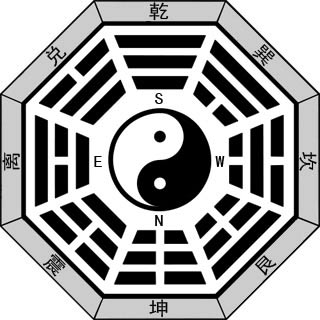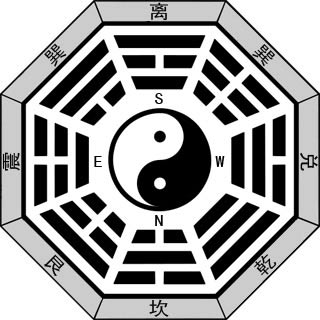I Ching (The Book of Changes)
I Ching, also Yi Jing or The Book of Changes, is thought to be the oldest and most abstruse classic in Chinese history. Reputedly, it originated with Fu Xi, who is a mythical sovereign being the first of the three primogenitors of Chinese civilization. It is also called Zhou Yi reputedly because it is not until the Western Zhou Dynasty that the whole context of I Ching was understood. The first king of Zhou, King Wen, concentrated on the study the mystery of changes when he was put in prison for seven years. It has been an aid to foretell the future and make decisions for thousands of years. However, it means more than a book of divination.
 |
| Tai Chi Symbol Represents Yin Yang |
Yin Yang
Here is the description in I-Ching about how world began:
The infinite produces limit and this is the supreme ultimate (Tai Chi or the absolute);
The Tai Chi produces two forms, Yin and Yang;
The two forms produce the four phenomena, shao yin, tai yin (the Moon), shao yang, tai yang (the Sun);
The four phenomena act on the eight trigrams (ba gua): sky, earth, mountain, water, wind, hire, thunder and lake/marsh.
There is another description: when the world began, there are heaven (sky) and earth. They mated to give birth to every thing in the world. Heaven is called the Qian trigram (Qian Gua) and the earth is Kun trigram (Kun Gua). The remain trigrams are Dui, Li, Zhen, Xun, Kan, Gen respectively representing lake, hire, thunder, wind, water and mountain.
Yin Yang and Chinese Medicine
Body visceral organs, channels and collaterals all have yin and yang sides. The upper part of the body is assigned to Yang, while the lower part to Yin. Health is based on the balance of yin and yang. Yang vacuity will represent heat sensations, dry mouth, night sweats, dark urine, etc, while the yang vacuity will represent cold limbs, slow pulse, bright white complexion, etc.
Ba Gua (Eight Trigrams)
Ba Gua is a set of symbolic signs. — represents Yang and –– represents Yin. Each of the eight trigrams consists of three signs, having the special meaning. The combination of the eight trigrams produces 64 trigrams which symbolize all the things and phenomenon in the nature and life. In Chinese traditional medicine, Ba Gua refers to the eight acupuncture points around the hollow of hands. It also refers to the gossip in the world of entertainment.
|
|
Symbols of the Eight Trigrams (Each trigram has more symbols than those listed below)
| Trigram | Nature | Feature | Body | Animal | Yin Yang | Wu Xing |
| Qian | Heaven | Bouncing | Head | Horse | Yang | Metal |
| Dui | Marsh | Pleasing | Mouth | Ram | Yin | Metal |
| Li | Fire | Clinging | Eye | Pheasant | Yang | Fire |
| Zhen | Thunder | Arousing | Foot | Dragon | Yin | Wood |
| Xun | Wind | Pneumatic | Thigh | Rooster | Yang | Wood |
| Kan | Water | Sinking | Ear | Cattle | Yin | Water |
| Gen | Mountain | Still | Hand | Dog | Yang | Earth |
| Kun | Earth | Receptive | Belly | Bull | Yin | Earth |
Each diagram corresponds to an aspect of life and cardinal direction. Therefore, the Ba Gua Hexagram is also a tool in Feng Shui used to map a room or location. The explanation on each trigram is complicated. It is undoubted the classic of ancient cosmic principles. I Ching, to be precise Ba Gua as a divination text has been long since regarded to serve the illiterate or superstitious person but conceded to be vain by scholars and elite.

